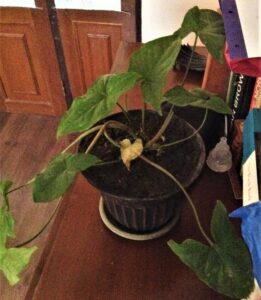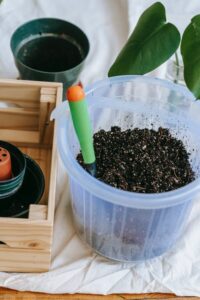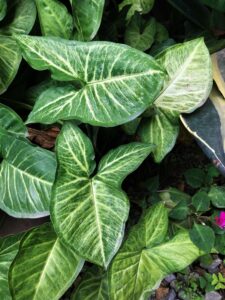Arrowhead plant is a beautiful plant that can suffer from a common problem in plants, appearing limp and drooping.
The name of the Arrowhead plant describes itself. Its unique arrow-like leaves make people fall in love with it.
Many place them indoors to soothe the aesthetic look of the house, whereas they can also be grown outside in your garden. They are fast-growing and easy to care for houseplants.
Usually, we tend to give close attention to our plants like babies. However, one day, you might find the Arrowhead plant limp and drooping despite the proper care or unaware factors.
Generally, the Arrowhead plants appear limp or drooping due to improper fertilizer, lighting and watering issues, low humidity, varying temperature, and overcrowded pot. Such factors can cause the plant to divert from its healthy state.

While your Arrowhead plant is supplying good humidity with air purification, it is not a pleasing sight to have them turn into an unhealthy-looking plant.
Nothing is ever wrong as much as we overthink. There are solutions and preventive measures for your concerned issues.
Let us run down what, why, and how your Arrowhead plant turns limp and droopy.
Table of Contents
Is it Normal for Arrowhead Plant to become Limp and Droopy?
Your Arrowhead plant turns limp and drooping due to various reasons related to lack of care. Their state can quickly change from good to bad even within 1 – 2 days.
Do not panic, though! It does not mean that your plants are dying.
It is commonly triggered due to overwatering them. However, few yellow leaves are possible due to their aging factor.
Likewise, it is normal if they seem limp and droopy somedays. But, again, you can fix them quickly. The cause behind this rapid change of state getting droopy is the plant’s long and heavy leaves.
Talking about your whole plant collapsing, you need to be wary about their yellow leaves, along with the entire plant becoming droopy with wilted leaves. Only this can lead to their ultimate death.
Everything cannot go perfect all the time while taking care of your numerous plants in different corners of your rooms and houses.
You might be unaware of some things or get caught up with work, hindering proper attention for your plants.
The following section will give you in-depth knowledge and exposure about what could have gone wrong while pampering your Arrowhead plants.
Causes of Limp and Droopy Leaves in Arrowhead Plant
There could be something or other that your Arrowhead plants are not happy about. Hence, it can make them sad and make them bend down.
| Causes | Prevention | Solution |
|---|---|---|
| Underwatering the Plant | Water every 2 to 3 days in summer and once a week in winter. | Keep watering until water drains out from the drainage holes of the pot. |
| Overwatering the Plant | Dry out before watering again. | Throw away the excess water that runs out from the drainage holes. |
| Low Humidity | Avoid having a low humidity level that is below 30%. | Use pebble trays, humidifiers, mist sprays. |
| Improper Lighting | Prevent from direct light; go for indirect bright lighting. | Shift them to near windows with sunlight. |
| Temperature Issues | Avert temperatures below 50ºF. | Keep monitoring room temperature and maintain 60ºF to 75ºF temperature. |
| Fertilizer Issues | Maintain well-drained fertile soil with a pH level of 5.5 to 6.5. | Repot your plants once every few years. |
1. Underwatering the Plant
Underwatering your plants is one of the common issues that causes your Arrowhead leaves to stoop. It is because they usually prefer moist soil rather than cracky dry ones.
The dry roots block in transporting the moisture to the stems and leaves of the plants, making them floppy and limp.
Likewise, completely dried out soil can even worsen the situation to turn the leaves brown.
A creative and easy way to determine whether your Arrowhead plant is underwatered is by lifting the pot. Usually, watered plants or wet soil tend to be heavier.
The soil of your plants generally tends to dry out faster, especially during their growing phase and warmer weather (summer and spring season).

Prevention
During summer, water your plants for a duration of every 2 to 3 days. Whereas during winter, only watering once a week is also enough.
Water your plants optimally as needed. Alongside the amount, be wary of the temperature factor of water too.
Do not shock your plant with cold showers. Lukewarm or room temperature water is the most suitable.
Solution
Constantly water your plant after checking its dryness. So how do you know when is the right time to rewater them?
Place your finger or wooden stick in the soil, and if the top 2 – 3 inches of soil is dry, it is time to shower your thirsty plant.
Water your plants until it drains out from the drainage holes of the plant pot.
Note: When your plants are dry, they might start getting saggy and slumped. Nevertheless, they can revive back to their original state once watered.
2. Overwatering the Plant
The term overwatering does not only mean watering too much, but it is also watering too often.
Excess watering is equally dangerous and another common reason for your plants to become bendy. Pooling and drowning your Arrowhead plants is strictly to be avoided.
Along with frequent watering, poorly aerated and waterlogging creates a similar problem of overwatering them. After that, issues such as root rot prevail.
However, be careful with your plants having wet feet causing root rot. It can seriously lead to the death of your plants too.
Prevention
Prevent your plant from overwatering by being aware of what is going on with your Arrowhead plant.
- Check if your soil is still wet for ten days or more.
- Give a chance to your plants to dry out before again watering them.
- Always opt for drainage hole pots while planting.
- Look out for soggy soil and smelly plant.
- Water your plants less during winter and fall.
Solution
Do not water the foliage of your plant but into the soil directly.
While your plant is already overwatered, do not keep the water-filled saucer underneath the pot. Instead, throw away the excess water that runs out from the drainage holes.
Doing this will prevent water logs and again soaking up the water by the soil more.
3. Low Humidity
A humid environment is the home of your Arrowhead plants as they originally come from South and Central America. They are tropical by nature.
We cannot have a perfect environment as many of us live in different corners with varying weather conditions.
Prevention
Try to avoid having a low humidity level that is below 30 percent. You can also use hygrometers to check the status of humidity of your room which is readily available on Amazon.
Strictly avoid keeping your Arrowhead plants in air conditioner rooms, central heating, or vents. They result in dry air, which immediately drops the level of humidity.
You can also place your plants in bathrooms (shower mists) or kitchens (steams from cooking) where the humidity level is naturally high. These are the perfect places to keep your Arrowhead plants if good lighting is available.
Solution
You can opt for various solutions if the humidity level of your surrounding goes down. Check the following.
- Pebble trays: Place your plant pot on top of a tray filled with pebbles and some water. Maintain space between the water and the bottom of the pot.
- Mist spray: Mist the leaves of your plants a couple of times in one week.
- Humidifiers: Try to place humidifiers near your plants. It is highly recommended out of the three options.
4. Improper Lighting
Arrowhead plants vastly prefer bright yet indirect sunlight.
Unsuitable lighting exposure to your Arrowhead plants can lead to unhealthy show-ups like floppy leaves followed by ultimate death if the condition deteriorates.
Arrowhead plants can survive in low light, but it slows their growth speed. You might also experience dark leaves of your plants caused by a lack of indirect sunlight.
Since it can survive in low light, it doesn’t die out until the situation gets significantly worse.
Therefore, taking action at the right time can amend the condition readily within 3 – 4 days.

Prevention
Place your Arrowhead plants near the window indoors or place them in a shaded area outside. Please do not leave them in the bright, scorching sunlight that might damage their leaves and plant as a whole.
Tip: The reflection received from mirrors or any glass objects also supplies them with enough lighting.
Solution
The way out for your flaccid Arrowhead leaves is shifting them to a bright light area.
Due to the lack of enough bright light, the plant receives fewer nutrients, leading to slacking leaves. As a result, they droop down and become limp.
Therefore, placing them in proper lighting areas can help them get back to their sturdy self.
5. Temperature Issues
The ideal temperature for your plants is between 60 to 75 degrees Fahrenheit. An extreme of coldness or hotness is not suitable for your Arrowhead plants.
Prevention
Try to avoid exposing your Arrowhead plants to low temperatures.
As the weather starts to get chilly, keeping your plants outdoor is not a good idea. Instead, bring them indoors during winter.
Note: The cold drafts not only limp and droop the leaves but can also leave them dead. This is usually common in temperatures below 50 degrees Fahrenheit.
Solution
Since we are in the digital era of getting things done efficiently, why spend money on thermometers when you don’t need to.
You can use various applications to check your room temperature and make sure your Arrowheads are receiving the right environment.
If your plant leaves are limp and floppy, check around for turned air conditioners and heaters quickly drying out the air.
6. Fertilizer Issues
Excess or even under-fertilization is not suitable for your plants.
Over supplying them causes leaf burns and eventually kills them by damaging their roots. Strictly avoid excess nitrogen, which most people usually mess up.
The most effective time to use fertilizers is during its growing season, which is spring and summertime.

Prevention
Provide balanced liquid fertilizer diluted 1/2 the recommended strength to your Arrowheads once every month, all year round. Apply it while you water your plants.
While applying any fertilizers, check on the intensity or strength and frequency of its utilization.
To keep up the quality of your plant soil, you should maintain well-drained fertile soil with a pH level of 5.5 to 6.5.
Solution
Sometimes unawareness can lead to excess fertilizers in the soil, creating white crusting on the soil’s surface. In these cases, the best option is to wash them off with water.
To do so, run or pour water for 5 minutes or more. It will gradually wash away the excess deposited salt in the soil.
This solution works amazingly. However, to be on the safer side, you can do it twice every year.
A reason for under fertilizing could be due to blockage of enough nutrients transporting in the soil or not repotting. So, if you suffer from it, then keep repotting your plants once every few years.
Not to worry, under-fertilized plants are easy to revive. With proper fertilization, they can revert to a healthy state within a few weeks.
Did you know that Crotons can turn limp and droopy too? Learn more here: Why are the Leaves on my Croton Limp and Drooping?
Tips to Take Care of Arrowhead Plant
You could accomplish half of the care for your Arrowhead plants from the causes and solutions of limp and droopy leaves above. Keep them in mind!
Other than that, read through the following points to have perfect growing Arrowhead plants at your home.

1. Arrowhead Plant Pruning
Pruning and slight trims once in a while keep your plants healthy. They look vibrant as well as fresh with their colors.
If the Arrowhead plant grows large, they turn into giant vines and possibly lose the unique shape of their leaves.
Be mindful of using clean tools (shears and scissors) while pruning your plants.

You can cut off the growing climbing stems coming out of the plants. It prevents you from not losing the shape of your Arrowhead plant leaves.
2. Use Pest Controls
Thrips, aphids, mealybugs, and spider mites are the most common predators attracted to Arrowhead plants.
Mealybugs are white cotton-like substances in puffs that stay on plants. You can remove them with a soft alcohol-rubbed cloth by wiping them off.
In pests like aphids and spider mites, shift your plant outside in the sun and let the warmth do its work. After a few hours, spray the leaves of Arrowhead with a strong gush of water.
You can also go with spraying neem oil or green solution or insecticides in the plants.
3. Repotting Arrowhead Plants
Overcrowded pot demands for repotting it! Living in the same pot can make your plant stuffy and unhealthy.
Since your Arrowhead plant is growing bushier and taller, changing them to a new pot is highly recommended.
When it’s time, you will see their roots coming out of drainage holes, and the plant looks too big for your tiny pot.

Also repotting to 1 – 2 sizes bigger is good, not too large and not too less.
Indoor trellis systems or hanging baskets are the best pots to be opting for repotting your plants.
Apart from the mentioned points, the below video can help you gain some practical visual insights on how to take care of your Arrowhead plants. Check it out!
Wrap-up time!
Arrowhead plants are not very difficult to maintain and grow. However, your small effort and attention can make them go a long way to a healthy life.
Keep the things I shared in this article to keep your Arrowhead plant from appearing limp and droopy in the future.
With that sorted out, as a plant lover like me, your house might be filled with other plants too. Similar issues can prevail in other plants with the problem of limp and droopy leaves.
Your Aloe Vera plant might be appearing droopy without you knowing it. Learn more: Why Is My Aloe Vera Plant Drooping?


